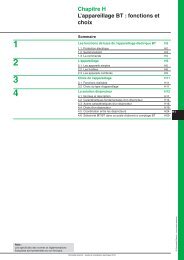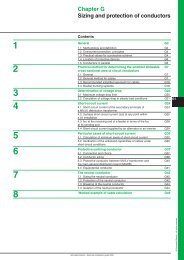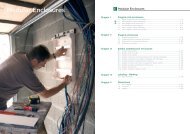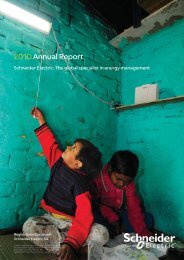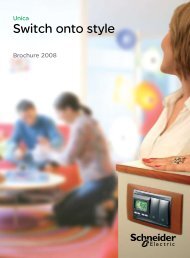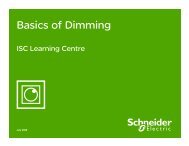Electrical Installation Guide 2009 - the global specialist in energy ...
Electrical Installation Guide 2009 - the global specialist in energy ...
Electrical Installation Guide 2009 - the global specialist in energy ...
- No tags were found...
Create successful ePaper yourself
Turn your PDF publications into a flip-book with our unique Google optimized e-Paper software.
B - Connection to <strong>the</strong> MV publicdistribution network1 Supply of power at mediumvoltageOverhead l<strong>in</strong>eAll IT-ear<strong>the</strong>d transformers, whe<strong>the</strong>r <strong>the</strong> neutral po<strong>in</strong>t is isolated or ear<strong>the</strong>d througha medium impedance, are rout<strong>in</strong>ely provided with an overvoltage limit<strong>in</strong>g devicewhich will automatically connect <strong>the</strong> neutral po<strong>in</strong>t directly to earth if an overvoltagecondition approaches <strong>the</strong> <strong>in</strong>sulation-withstand level of <strong>the</strong> LV system.In addition to <strong>the</strong> possibilities mentioned above, several o<strong>the</strong>r ways <strong>in</strong> which <strong>the</strong>seovervoltages can occur are described <strong>in</strong> Clause 3.1.This k<strong>in</strong>d of earth-fault is very rare, and when does occur is quickly detected andcleared by <strong>the</strong> automatic tripp<strong>in</strong>g of a circuit-breaker <strong>in</strong> a properly designed andconstructed <strong>in</strong>stallation.Safety <strong>in</strong> situations of elevated potentials depends entirely on <strong>the</strong> provision ofproperly arranged equipotential areas, <strong>the</strong> basis of which is generally <strong>in</strong> <strong>the</strong> form of awidemeshed grid of <strong>in</strong>terconnected bare copper conductors connected to verticallydrivencopper-clad (1) steel rods.The equipotential criterion to be respected is that which is mentioned <strong>in</strong> Chapter Fdeal<strong>in</strong>g with protection aga<strong>in</strong>st electric shock by <strong>in</strong>direct contact, namely: that <strong>the</strong>potential between any two exposed metal parts which can be touched simultaneouslyby any parts <strong>the</strong> body must never, under any circumstances, exceed 50 V <strong>in</strong> dryconditions, or 25 V <strong>in</strong> wet conditions.Special care should be taken at <strong>the</strong> boundaries of equipotential areas to avoid steeppotential gradients on <strong>the</strong> surface of <strong>the</strong> ground which give rise to dangerous “steppotentials”.This question is closely related to <strong>the</strong> safe earth<strong>in</strong>g of boundary fences and is fur<strong>the</strong>rdiscussed <strong>in</strong> Sub-clause 3.1.B111.2 Different MV service connectionsAccord<strong>in</strong>g to <strong>the</strong> type of medium-voltage network, <strong>the</strong> follow<strong>in</strong>g supply arrangementsare commonly adopted.Fig. B11 : S<strong>in</strong>gle-l<strong>in</strong>e serviceS<strong>in</strong>gle-l<strong>in</strong>e serviceThe substation is supplied by a s<strong>in</strong>gle circuit tee-off from a MV distributor (cable orl<strong>in</strong>e).In general, <strong>the</strong> MV service is connected <strong>in</strong>to a panel conta<strong>in</strong><strong>in</strong>g a load-break/isolat<strong>in</strong>g switch-fuse comb<strong>in</strong>ation and earth<strong>in</strong>g switches, as shown <strong>in</strong> Figure B11.In some countries a pole-mounted transformer with no MV switchgear or fuses(at <strong>the</strong> pole) constitutes <strong>the</strong> “substation”. This type of MV service is very common <strong>in</strong>rural areas.Protection and switch<strong>in</strong>g devices are remote from <strong>the</strong> transformer, and generallycontrol a ma<strong>in</strong> overhead l<strong>in</strong>e, from which a number of <strong>the</strong>se elementary service l<strong>in</strong>esare tapped.Underground cabler<strong>in</strong>g ma<strong>in</strong>Fig. B12 : R<strong>in</strong>g-ma<strong>in</strong> service(1) Copper is cathodic to most o<strong>the</strong>r metals and <strong>the</strong>reforeresists corrosion.(2) A r<strong>in</strong>g ma<strong>in</strong> is a cont<strong>in</strong>uous distributor <strong>in</strong> <strong>the</strong> form of aclosed loop, which orig<strong>in</strong>ates and term<strong>in</strong>ates on one set ofbusbars. Each end of <strong>the</strong> loop is controlled by its own circuitbreaker.In order to improve operational flexibility <strong>the</strong> busbarsare often divided <strong>in</strong>to two sections by a normally closed bussectioncircuit-breaker, and each end of <strong>the</strong> r<strong>in</strong>g is connectedto a different section.An <strong>in</strong>terconnector is a cont<strong>in</strong>uous untapped feeder connect<strong>in</strong>g<strong>the</strong> busbars of two substations. Each end of <strong>the</strong> <strong>in</strong>terconnectoris usually controlled by a circuit beaker.An <strong>in</strong>terconnector-distributor is an <strong>in</strong>terconnector whichsupplies one or more distribution substations along its length.R<strong>in</strong>g-ma<strong>in</strong> serviceR<strong>in</strong>g-ma<strong>in</strong> units (RMU) are normally connected to form a MV r<strong>in</strong>g ma<strong>in</strong> (2) or<strong>in</strong>terconnector-distributor (2) , such that <strong>the</strong> RMU busbars carry <strong>the</strong> full r<strong>in</strong>g-ma<strong>in</strong> or<strong>in</strong>terconnector current (see Fig. B12).The RMU consists of three units, <strong>in</strong>tegrated to form a s<strong>in</strong>gle assembly, viz:b 2 <strong>in</strong>com<strong>in</strong>g units, each conta<strong>in</strong><strong>in</strong>g a load break/isolat<strong>in</strong>g switch and a circuitearth<strong>in</strong>g switchb 1 outgo<strong>in</strong>g and general protection unit, conta<strong>in</strong><strong>in</strong>g a load-break switch andMV fuses, or a comb<strong>in</strong>ed load-break/fuse switch, or a circuit-breaker and isolat<strong>in</strong>gswitch, toge<strong>the</strong>r with a circuit-earth<strong>in</strong>g switch <strong>in</strong> each case.All load-break switches and earth<strong>in</strong>g switches are fully rated for short-circuit currentmak<strong>in</strong>gduty.This arrangement provides <strong>the</strong> user with a two-source supply, <strong>the</strong>reby reduc<strong>in</strong>gconsiderably any <strong>in</strong>terruption of service due to system faults or operations by <strong>the</strong>supply authority, etc.The ma<strong>in</strong> application for RMUs is <strong>in</strong> utility supply MV underground-cable networks <strong>in</strong>urban areas.© Schneider Electric - all rights reservedSchneider Electric - <strong>Electrical</strong> <strong>in</strong>stallation guide <strong>2009</strong>




